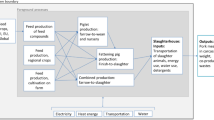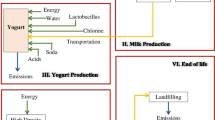Abstract
Purpose
Food production without consuming scarce local freshwater resources in an unsustainable way needs to be ensured. A robust method to assess water scarcity impacts is needed, not only for areas suffering from water scarcity but also in circumstances without water scarcity. This study provides basic knowledge about the current water scarcity footprint methodologies applied to rain-fed agriculture, with Finnish milk production as a case study.
Methods
A typical Finnish “cradle-to-dairy” milk production system was studied. An improved allocation method is suggested taking into account that a lactating cow consumes more drinking water due to milk production. Impact assessment methodologies, including midpoint impact indicators of water deprivation and water scarcity, and the endpoint impact indicators on human health, ecosystems and resources, were applied and evaluated.
Results and discussion
Finnish milk is associated with quite low consumptive water use, amounting to just 6.3 l per litre of packaged skimmed milk according to the suggested allocation method. The stress-weighted water footprint was 4.3 H2Oeq, and the water scarcity impact came to 12.2 leq per litre of Finnish milk. The comparisons between this study and case studies in the literature showed that the water scarcity impact results calculated with the AWARE method are well reasoned, and that mass flows from regions with high water scarcity cause higher water scarcity impact.
Conclusions
We conclude that the water scarcity footprint of Finnish milk in all the studied impact categories is relatively low. The AWARE method for water scarcity footprint assessment seems to be particularly applicable for Finland and is able to identify the critical hotspots of production chains.



Similar content being viewed by others
References
Allan JA (1993) Fortunately, there are substitutes for water otherwise our hydro-political futures would be impossible. Proceedings of the Conference on Priorities for Water Resources Allocation and Management. Overseas Development Administration ODA, pp 13–26
Allan JA (1997) “Virtual water”: a long term solution for water short middle eastern economies? British Association Festival of Science, Water and Development Session – TUE.51, 14.45, University of Leeds, 9 September 1997
Boulay A-M, Hoekstra AY, Vionnet S (2013) Complementarities of water-focused life cycle assessment and water footprint assessment. Environ Sci Technol 47(21):11926–11927
Boulay A-M, Bare J, De Camillis C, Döll P, Gassert F, Gerten D, Margni M et al (2015) Consensus building on the development of a stress-based indicator for lca-based impact assessment of water consumption: outcome of the expert workshops. Int J Life Cycle Assess 20:577–583
Boulay A-M, Bare J, Benini L, Berger M, Lathuillière MJ, Manzardo A, Margni M, Motoshita M, Núñez M, Pastor AV, Ridoutt B, Oki T, Worbe S, Pfister S (2018) The WULCA consensus characterization model for water scarcity footprints: assessing impacts of water consumption based on available water remaining (AWARE). Int J Life Cycle Assess 23:368–378
Castle ME, Thomas TP (1970) The water intake of British Friesian cows on ration containing various forages. Anim Prod 20:181–189
Chapagain AK, Hoekstra AY, Savenije HHG, Gautam R (2006) The water footprint of cotton consumption: An assessment of the impact of worldwide consumption of cotton products on the water resources in the cotton producing countries. Ecol Econ 60(1):186–203
Cote CM, Moran CJ, Cummings J, Ringwood K (2009) Developing a water accounting framework for the Australian minerals industry. Trans Inst Min Metall Sect A 118(3):162–176
De Boer IJM, Hoving IE, Vellinga TV, Van de Ven GWJ, Leffelaar PA, Gerber PJ (2013) Assessing environmental impacts associated with freshwater consumption along the life cycle of animal products: the case of Dutch milk production in Noord-Brabant. Int J Life Cycle Assess 18:193–203
Edström M, Pettersson O, Nilsson L, Hörndahl T (2005) Jordbrukssektorns energianvändning. JTI-rapport. Lantbruk & Industri 342. JTI – Institutet för jordbruks- och miljöteknik
EEA (2003) Europe’s water: an indicator-based assessment summary. Available at: http://edz.bib.uni-mannheim.de/daten/edz-bn/eua/03/2_water.pdf
ETL (2017) Finnish Food and Drink Industries’ Federation / statistics. www.etl.fi
FAO (2013) AQUASTAT database. Food and Agriculture Organization of the United Nations
Feitz AJ, Lundie S, Dennien G, Morian M, Jones M (2007) Generation of an industry-specific physico-chemical allocation matrix, application in the dairy industry and implications for systems analysis. Int J Life Cycle Assess 12(2):109–117
Finnish Water Utilities Association (2012) Välttämätön vesi. Available at: http://www.vvy.fi/files/2228/valttamaton_vesi_8_6_2012_netti.pdf
Goedkoop M, Spriensma R (2001) The Eco-Indicator 99: a damage oriented method for life cycle impact assessment: methodology report, Publikatiereeks produktenbeleid; Nr. 36A; Ministerie van Volkshiusvesting, Ruimtelijke Ordening en Milieubeheer: Den Haag
Gyllenswärd M (2011) Mjölkavhämtningsrum - Vägledning för planering och utformning. Svensk Mjölk
Hoekstra AY, Chapagain AK (2007) The water footprints of Morocco and the Netherlands: global water use as a result of domestic consumption of agricultural commodities. Ecol Econ 64:143–151
Huang J, Xu C-C, Ridoutt BG, Liu J-L, Zhang H-L, Chen F, Yu L (2014) Water availability footprint of milk and milk products from large-scale dairy production system in Northeast China. J Clean Prod 79:91–97
IDF (2010) A common carbon footprint approach for dairy. The IDF guide to standard lifecycle assessment methodology for the dairy sector. Bulletin of the International Dairy Federation 445/2010
IDF (2015) A common carbon footprint approach for the dairy sector. The IDF guide to standard lifecycle assessment methodology. Bulletin of the International Dairy Federation 479/2015
IDF (2017) The IDF guide to water footprint methodology for the dairy sector. Bulletin of the International Dairy Federation 486/2017
ISO 14046:2014 (2014) Environmental management—water footprint—principles, requirements and guidelines. International Organisation for Standardisation, Geneva, Switzerland
Jylhä P (2013) Autohakkurin seula-aukon vaikutus kokopuun haketuksen tuottavuuteen ja polttoaineen kulutukseen. Working Papers of the Finnish Forest Research Institute 272
KTBL (2008) Wasserversorgnung in der Rinderhaltung Wasserbedarf - Technik - Management, 81, Kuratorium für Technik und Bauwersen in der Landwirtschaft e.V, Darmstadt
Kuoppala K, Khalili H, Jaakkola S (2004) Water intake and drinking behaviour of dairy cows offered grass silage. In: Proceedings of the 38th international congress of the ISAE - International Society for Applied Ethology, Helsinki, Finland 2004 / Editors Laura Hänninen & Anna Valros. International Society for Applied Ethology. p 149
Lindgaard Jensen M (2009) Power and Water Consumption with AMS. FarmTest 61. Danish Agricultural Advisory Service. http://www.milkproduction.com/Documents/Farmtest61-AMS-UK-web.pdf. Accessed 10 August 2018.
Luke (2017) Feed tables and nutrient requirements. Natural Resources Institute Finland (Luke). [cited 12.5.2017]. Available at: http://www.luke.fi/feedtables
Mäki M, Manninen E, Nyman K (2005) Maitotilan pesuopas. MTT
Mälkki H, Virtanen Y (2003) Selected emissions and efficiencies of energy systems based on logging and sawmill residues. Biomass Bioenergy 24(4–5):321–327
McDonald P, Edwards RA, Greenhalgh JFD (1988) Animal nutrition, vol 19, 4th edn. Longman, New York, p 523
Mekonnen MM, Hoekstra AY (2011) National water footprint accounts: the green, blue and grey water footprint of production and consumption, Value of Water Research Report Series No. 50. UNESCO-IHE, Delft
Mikkola H, Ahokas J (2009) Energy ratios in Finnish agricultural production. AFSci 18:332–346
MMM (2012) Decree of the Finnish Ministry of Agriculture and Forestry 32/2012
Murphy E, de Boer IJM, van Middelaar CE, Holden NM, Shalloo L, Curran TP, Upton J (2017) Predicting freshwater demand on Irish dairy farms using farm data. J Clean Prod 140:547–555
Northey S, Haque N, Mudd G (2013) Using sustainability reporting to assess the environmental footprint of copper mining. J Clean Prod 40:118–128
Nousiainen J, Tuori M, Turtola E, Huhtanen P (2011) Dairy farm nutrient management model. 1. Model description and validation. Agric Syst 104:371–382
Pajula H, Järvenpää L (eds) (2007) Maankuivatuksen ja kastelun suunnittelu: työryhmän mietintö. Suomen ympäristökeskuksen raportteja 23/2007. Suomen ympäristökeskus, Helsinki
Pajula H, Triipponen J (eds) (2003) Selvitys Suomen kastelutilanteesta: esimerkkialueena Varsinais-Suomi. Suomen ympäristö 629, luonto ja luonnonvarat Suomen ympäristökeskus, Helsinki
Pfister S, Koehler A, Hellweg S (2009) Assessing the environmental impacts of freshwater consumption in LCA. Environ Sci Technol 43:4098–4104
Posio M (2010) Kotieläintilojen energiankulutus. (Energy usage of domestic farms). M.Sc. Thesis. Faculty of Agriculture and Forestry. Department of Agricultural Sciences
ProAgria (2010) The Finnish dairy herd recording system. Association of ProAgria Centres
ProAgria (2012) The Finnish dairy herd recording system. Association of ProAgria Centres
Ramos S, Ridoutt BG, Sanguansri P, Zufia J (2016) Evaluating the suitability of three water scarcity footprint methods: case study for the Spanish dairy industry. Proceedings 10th International Conference on Life Cycle Assessment of Food, Dublin, 19–21, Oct. 2016
Rasmussen JB, Pedersen J (2004) Electricity and water consumption at milking. Farm Test 17. Danish Agricultural Advisory Service
Ridoutt BG, Hodges D (2017) From ISO14046 to water footprint labelling: a case study of indicators applied to milk production in south-eastern Australia. Sci Total Environ 599–600:14–19
Ridoutt BG, Pfister S (2010) A revised approach to water footprinting to make transparent the impacts of consumption and production on global freshwater scarcity. Glob Environ Change 20:113–120
Ridoutt BG, Williams SRO, Baud S, Fraval S, Marks N (2010) Short communication: the water footprint of dairy products: case study involving skim milk powder. J Dairy Sci 93:5114–5117
Shiklomanov IA, Rodda JC (eds) (2003) World water resources at the beginning of the twenty-first century. Cambridge University Press, Cambridge
StoraEnso (2011) Case study on the water footprint of StoraEnso’s Skoghall mill. Report to the Alliance of Beverage Cartons and Environment (ACE) and WWF. Available at: http://www.beveragecarton.eu/uploads/Modules/Publications/case_study_on_the_water_footprint.pdf. Accessed 18 June 2013
Sultana MN, Uddin MM, Ridoutt BG, Peters KJ (2014) Comparison of water use in global milk production for different typical farms. Agric Syst 129:9–21
Thoma G, Jolliet O, Wang Y (2013) A biophysical approach to allocation of life cycle environmental burdens for fluid milk supply chain analysis. Int Dairy J 31:S41–S49
Tike (2012) Agricultural census 2010 Part 2. Tike, Information Centre of the Ministry of Agriculture and Forestry. http://docplayer.fi/2447475-Maatalouslaskenta-2010.html. Accessed 10 August 2018.
Uppenberg S, Zettenberg L, Åhman M (2001) Climate impact from peat utilisation in Sweden IVL B-1423. Stockholm, Sweden
Usva K, Virtanen E, Hyvärinen H, Nousiainen J, Sinkko T, Kurppa S (2014) Water in an LCA framework: applying the methodology to milk production in Finland. In: 9th International Life Cycle Assessment for Foods Conference. Available at: http://lcafood2014.org/papers/208.pdf
Virtanen E (2015) Water footprint of Finnish milk production. Pro gradu. University of Helsinki
Zonderland-Thomassen MA, Ledgard SF (2012) Water footprinting - A comparison of methods using New Zealand dairy farming as a case study. Agric Syst 110:30–40
Zubarevich NV (2013) Regional Development: In Search of Sustainability. In: UNDP National Human Development Report for the Russian Federation 2013 Sustainable Development: Rio Challenges. Table 7.2. Available at: http://www.undp.ru/index.php?lid=1&cmd=publications1&id=48
Acknowledgements
We would like to thank Stephen Pfister, Marlies Zonderland-Thomassen and Anne-Marie Boulay for their assistance in interpreting and applying their methods and results.
This work was supported by MTT Agrifood Research Finland.
Author information
Authors and Affiliations
Corresponding author
Additional information
Responsible editor: Stephan Pfister
Rights and permissions
About this article
Cite this article
Usva, K., Virtanen, E., Hyvärinen, H. et al. Applying water scarcity footprint methodologies to milk production in Finland. Int J Life Cycle Assess 24, 351–361 (2019). https://doi.org/10.1007/s11367-018-1512-2
Received:
Accepted:
Published:
Issue Date:
DOI: https://doi.org/10.1007/s11367-018-1512-2




